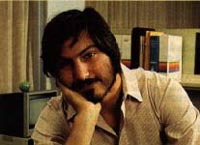click on home button to open mainpage

Steve Jobs
Steve Wozniac papers & manuals hardware software |
General Steve Wozniak's design for the first Apple computer exemplified the elegance in circuitry towards which computer hobbyists aspired. Working in part at the informal Homebrew Computer Club in Palo Alto, California, Wozniak crafted a single circuitboard regarded by fellow hobbyists as "a beautiful work of art" (Levy, 81). His computer comprehensively integrated a version of Motorola's new 6800 processor instead of the far more common 8080 from Intel, a choice originally based on price (Carlton, 38). Wozniak's friend Steve Jobs insisted that they start a company to sell these machines, and Apple Computer was created in April 1976. At $666.66 each, the Apple I computers sales gradually increased, attracting the attention of investor Armas Clifford (Mike) Markkula. Apple incorporated on January 3, 1977 and moved to a separate building from the makeshift workshop in the garage of Jobs' parents' home (Carlton, 9-10). The Apple I did not require the assembly of computer kits, but also did not come in a case. Building an enclosure was an opportunity for the self-expression of the user who appreciated but could not equal the elegance of Wozniak's electronics design. This expression varied considerably, "from simple pine boxes and polished cherrywood containers with integrated keyboards to rugged brushed aluminum and black metal boxes with rivets on the sides, which evinced a high-tech look. One owner even installed his Apple I inside a leather briefcase, with the circuitboard in the top, a keyboard bolted to the bottom and a lamp cord trailing out the back, creating the first laptop computer." No standard appearance had developed for a microcomputer, and large business computers, generally impersonal cabinets enclosed in dark sheet metal, did not provide an obvious model (Kunkel, 12-3). A personal computer was more than an oxymoron; it was inconceivable to many even in the mainframe computer industry - a variously identified executive at Hewlett-Packard reportedly rejected Wozniak's offer of the Apple I design, saying that people would not want computers on their desks at home (Butcher, 63). The appearance of the early personal computer could be shaped by an individual owner with few preconceptions. Specifications
Description Chronology |
![]()
| Last Updated on 9 October, 2002 | For suggestions please mail the editors |
Footnotes & References
| 1 | smithsonian museum - apple 1 replica |
| 2 | Bruce
Flamm, Co-Editor of IACC. The International Association of Calculator Collectors . © 1996 IACC Spring 1996 issue #12 |